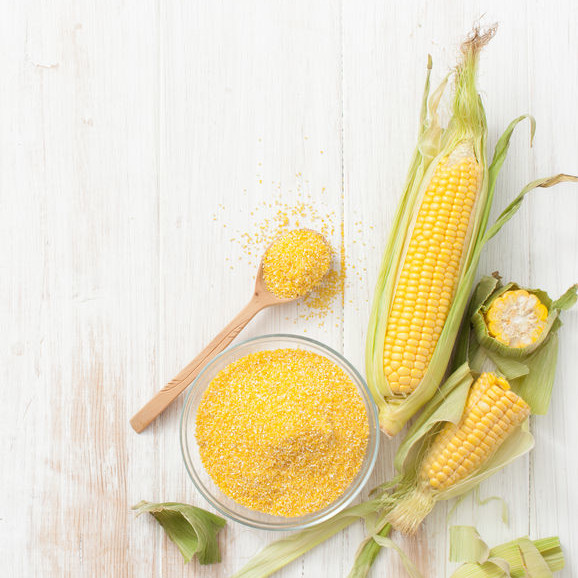
Cornmeal
What is Cornmeal?
Cornmeal is a coarsely milled product obtained from dried corn (maize) kernels. It is the mid-size fraction of ground corn and is available in various colors (blue, purple, yellow and white) depending on the corn color itself.
It is gluten-free and the basic component of many food and bakery products such as:
- Polenta
- Cornbread
- Muffins
- Stews
- Cereals
- Chips
- Masa
- Breadings
Origin
Traditionally, cornmeal was obtained from stone-ground corn kernels. This preserved the corn nutrients, mainly its fiber content as well as its desirable flavor profile. Due to fat oxidation during storage, this process was no longer viable and modern grinding techniques were introduced in various parts of the world to produce cornmeal.
Function
Cornmeal is a gluten-free flour and is used in making bakery goods and extruded snacks. Because this ingredient lacks gluten, it does not expand upon baking and often results in dense structure.
Commercial production
This ingredient is produced using a dry milling method. Processing steps include:
- Cleaning
- Drying
- Removing impurities (eg., dirt)
- Tempering at 20% moisture content
- Removing germ and hull
- Grinding and milling the endosperm through roller mills
- Sifting and removing impurities
- Separating into different particle sizes based on the needs
- Packaging
Three distinct products are separated at the end of the process: coarse-ground particles, medium- ground cornmeal, and very small particles or corn flour. Commercially, the medium-ground fraction is what is referred to as cornmeal while the fine-ground is known as corn flour. Large-size ground corn particles are known as grits.
Cornmeal obtained from this process is labeled steel-ground and is the most common type in the United States. They do not contain any portion of the hull or germ, making it easier to use in baking. However, they are less nutritious than stone-ground cornmeal.
Composition and nutrition
Typical nutrients composition/100 g:1
| Component | Amount |
| Energy | 357 kcal |
| carbohydrate | 80.95 g |
| Protein | 7.14 g |
| Fiber, total dietary | 2.4 g |
| Total lipid | 0 g |
| Iron, Fe | 0.86 mg |
This ingredient is also rich in B-vitamins especially thiamine and riboflavin as well as beneficial antioxidants.
Application
Cornmeal is a very versatile ingredient in cooking and baking. In snacks, it is often used in combination with rice or other grain flour to provide adequate expansion and puffing. It can be used to make bakery goods such as:2
- Tortilla
- Fried bread
- Corn bread
- Muffin
- Biscuits
- Cookies
- Cakes
FDA regulation
White and yellow cornmeal are regulated by FDA under 21CFR137.2503 and 21CFR137.2754, respectively.
References
- Cornmeal. Accessdata. Fda. gov. April 01. 2019. https://fdc.nal.usda.gov/fdc-app.html#/food-details/519405/nutrients. Last accessed by Fed 11. 2020.
- 5 smart ways to use cornmeal. https://www.thekitchn.com/5-smart-ways-to-use-cornmeal-pantry-tips-from-the-kitchn-218766. Last accessed by Fed 11. 2020.
- CFR – Code of Federal Regulations 21CFR137.250. Accessdata. Fda. gov. April 01. 2019. https://www.accessdata.fda.gov/scripts/cdrh/cfdocs/cfcfr/CFRSearch.cfm?fr=137.250. Last accessed by Fed 11. 2020.
- CFR – Code of Federal Regulations 21CFR137.275.Accessdata. Fda. gov. April 01. 2019. https://www.accessdata.fda.gov/scripts/cdrh/cfdocs/cfcfr/CFRSearch.cfm?fr=137.275. Last accessed by Fed 11. 2020.

